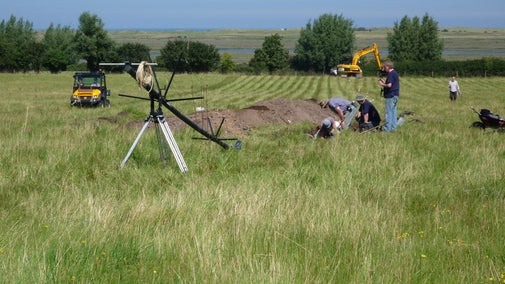Branodunum Roman Fort

Jump to
Just outside Brancaster is the site of the ancient Roman fort of Branodunum. The fort, built in the 230s, later became part of the Saxon Shore fortification system.
A geophysical survey and archaeological dig across five trenches were carried out by the Time Team television programme in 2012.
Several previously unknown buildings inside the fort were discovered, including huge granaries, barrack blocks for the soldiers, and a possible bath house. The dig also uncovered various artefacts pre-dating circa 225-250 AD.
Meeting place for the Empire
First, an infantry unit from Gaul (modern France) was stationed at Branodunum and then later cavalry from Dalmatia (modern Croatia and Bosnia).
Soldiers and traders from other nations would have passed through the fort, and all would have mingled with British people in the village (vicus) outside its walls. The Roman beach was where naval and trading vessels would have been drawn up.
Lifelines of the Empire
Each week, Roman soldiers would look out for ships arriving with luxuries and essentials. They would anxiously await news, letters from family or friends, for these ships were the lifeline with home.
The fort was linked by roads and sea, to other forts along the coast, to Roman towns, and to the ports of the Empire.

The Saxon Shore forts
Branodunum is one of eleven forts along the south and east coasts of England, known as the Saxon Shore forts. The Romans built these forts during the 3rd century AD.
At first, they were used to protect and control shipping and trade around the coast; later they helped repel raiders from across the North Sea.
The forts remained military stations for over 150 years before being abandoned when the Roman army withdrew from Britain.
A 4th century Roman document, the Notitia Dignitatum, is the only surviving reference to the ‘Saxon Shore’. It depicts the nine forts that were under the command of the Count of the Saxon Shore.
These are: Othonae (Bradwell, Essex), Dubris (Dover, Kent), Lemannis (Lympne, Kent), Branodunum (Brancaster, Norfolk), Gariannonor (Caister-on-Sea/Burgh Castle, Norfolk), Regulbio (Reculver, Kent), Rutupis (Richborough, Kent), Anderidos (Pevensey, East Sussex) and Portum Adurni (Portchester, Hants).
An ever-changing coastline
Over 1,600 years since Branodunum fell out of use, sandbanks out at sea have risen into sand dunes and now the creek between the fort and the dunes is shallow and inaccessible to large vessels.
Because it stands on high ground, protected by dunes, Branodunum should look out over an ever-changing coastline for another 1,600 years.
You might also be interested in
Time Team to return to Branodunum
Time Team has announced that it will be carrying out new geophysical surveys at the site of Branodunum Roman Fort, Brancaster.

Looking after the archaeology of the coast
National Trust staff and volunteers help preserve dozens of archaeological sites along the north Norfolk coast – from Roman fortifications to Cold War installations.

Brancaster Estate and the D-Day landings
Discover the part that Brancaster Beach played in the D-Day landings that took place during the Second World War.
